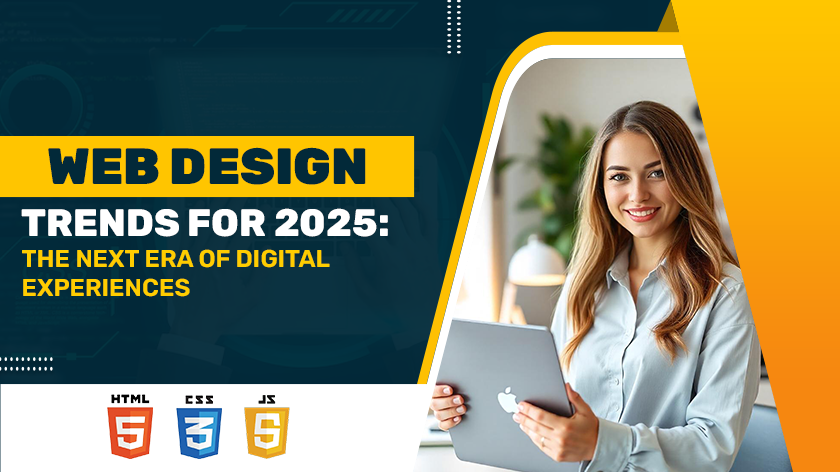As 2025 approaches, designers focus on producing attractive, inventive, and user-centric experiences. This blog examines the major web design trends that will rule in 2025 and transform both companies’ and users’ digital experiences.
1. Hyper-Personalization in Design: Web design is evolving past the traditional dynamic content driven by user preferences. By 2025, AI algorithms will enable websites to instantly adjust their layouts, themes, and even interactive elements, tailoring the experience to the specific needs of each visitor. Picture visiting a site where the design shifts in real-time to align with your preferred color palette, font style, or browsing behavior—creating a truly personalized experience.
Key Takeaway: Businesses must leverage AI and user data to create tailored digital environments that enhance engagement.
2. Immersive 3D Visuals: The integration of 3D elements is no longer limited to gaming or virtual reality. Websites are now adopting realistic 3D visuals that add depth and interactivity. These elements, coupled with AR/VR technologies, provide users with an immersive experience, making brands more memorable.
Example: E-commerce websites allow users to view products in a 3D virtual showroom.
3. Minimalism Meets Boldness: Minimalist design remains timeless, but in 2025, it’s evolving to incorporate bold typography, vibrant colors, and dynamic visuals. This trend focuses on delivering impactful designs while maintaining a clutter-free aesthetic.
Tip: Striking a balance between simplicity and boldness ensures websites are both functional and visually compelling.
4. Voice-Activated Interfaces: With the proliferation of smart devices, voice interaction is becoming a cornerstone of modern web design. Websites optimized for voice commands will improve accessibility and cater to a broader audience.
Use Case: Voice-activated navigation on e-commerce platforms to streamline product searches.
5. AI-Driven Chatbots and Virtual Assistants: AI chatbots are no longer just customer support tools; they are evolving into virtual assistants that can guide users through complex interactions. By 2025, these bots will become more human-like, offering contextual, emotion-aware responses to enhance user satisfaction.
Example: A virtual assistant that suggests blog topics or content ideas based on browsing history.
6. Micro-Interactions for Engagement: Micro-interactions and invisible movements increase user engagement by offering pleasure and immediate feedback. These simple yet powerful design cues, such as a hover effect or button movement, keep people interested in the experience.
Pro Tip: Use micro-interactions sparingly to avoid overwhelming users.
7. Sustainability and Green Web Design: As environmental concerns grow, sustainable web design is gaining traction. This trend involves creating lightweight websites with optimized performance to reduce energy consumption.
Actionable Insight: Prioritize eco-friendly hosting and minimalist code to lower your website’s carbon footprint.
8. Dynamic and Fluid Layouts: Static grid-based layouts are giving way to fluid and dynamic designs that adjust seamlessly to user interactions and screen sizes. These layouts prioritize versatility, ensuring a consistent experience across all devices.
Example: A homepage that changes its layout based on user engagement patterns.
9. Inclusive Design for Accessibility: Web accessibility is no longer optional. In 2025, inclusive design will be a fundamental requirement for websites, ensuring usability for people with disabilities. Features like screen reader compatibility, voice commands, and adjustable text sizes will become standard.
Takeaway: Designing for inclusivity enhances brand reputation and broadens audience reach.
10. The Rise of AI-Generated Content and Design: AI technologies are influencing the direction of web design by creating content, automating difficult processes, and even creating. AI and designers will work together in 2025 to provide quick prototyping and customized experiences.
Example: AI-powered design platforms like Figma leveraging machine learning for real-time suggestions.
Conclusion: Embracing the Future of Web Design
The trends of 2025 highlight a shift towards creating dynamic, user-focused, and technology-driven digital experiences. From hyper-personalization to sustainability, these innovations are set to redefine the web design landscape.
Our focus at XcelTec is creating innovative, trend-aligned online solutions customized to meet your company’s demands. Together, let’s create a future-proof website that offers outstanding digital experiences.
For more information: https://www.xceltec.com/
 :
https://in.pinterest.com/xceltec0192/
:
https://in.pinterest.com/xceltec0192/












